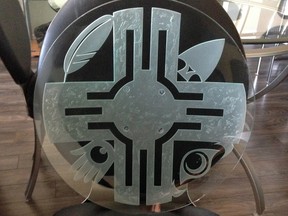
Reviews and recommendations are unbiased and products are independently selected. Postmedia may earn an affiliate commission from purchases made through links on this page.
Article content
Q I purchased this shallow glass bowl at a garage sale. It is 43 cm in diameter (17 inches), perfect and has an etched signature “Susan A. Point 1996” at the outer edge. My research indicates that she is a very well known Indigenous artist. I would like to know how much it’s worth. Thanks very much.
Suzanne, Aylmer, Que.
Article content
A You have found an art treasure of artist Susan Point, also known as Susan A. Sparrow. She was born in Alert Bay in 1952 and raised in the First Nations community of Musqueam, which lies within the city of Vancouver. Her symbolic work is in the style and tradition of the Coast Salish people – often based on spindle whorls used in spinning wool. Not only is she an officer of the Order of Canada, she also holds the National Aboriginal Achievement Award (now called Indspire Awards) – a highest honour of the Indigenous community. A prolific artist, the work of Point includes printmaking, jewellery and painting – some is monumental such as the massive cedar owl showcased at Vancouver’s International airport and the Welcome Figures at the escalator of the Canada Customs Hall. Your carved glass bowl is easily worth $1,500 today.
Advertisement 2
Article content

Q This picture has been in our family forever and it seems to generate a lot of interest. I am curious why. I don’t know where it came from but my husband’s family ran a pool hall at one time. With the frame it measures 60 by 45 cm (24 x 18 inches). Thanks very much.
Ruby,
Kitchener, Ont.
A This “paper-under-glass” image was meant as a decorative advertisement for Labatt (later Labatt’s) to hang in retail outlets. It first appeared in the mid-1890s and was probably used for some years after. The same image was used for a beer tray and later it also appeared on calendars. Advertising is hot and this piece is desirable. The original frame and brass title plaque separate it to a higher level over those without. Since most everything can be found online, these days it might not be thought of as rare – but it is with a value of $1,000 today.

Q We have been told this cane is made of either the bones or the spinal column of a shark. My grandfather was a ship’s captain from Nova Scotia in the early 1900s. The cane is 89 cm long (35 inches) and is a little warped. I have no further information. Could you advise please? Thank you.
Advertisement 3
Article content
Jeannette, Dieppe, N.B.
A They are bones (vertebrae) from a spinal column but could also be from a large ray. The likely maker would be as a gift from a seafarer on your captain’s ship with the purpose being for show (fashion) as a walking stick as opposed to an actual aid for walking. It dates to the late 1800s or early 1900s. It’s nice to have the provenance recorded with the item. Such sticks are scarce and popular with walking stick/cane collectors and the marine crowd. I’d say it’s worth about $750.
John Sewell is an antiques and fine art appraiser. To submit an item to his column, go to the ‘Contact John’ page at www.johnsewellantiques.ca. Please measure your piece, say when and how you got it, what you paid and list any identifying marks. A high-resolution jpeg photo must also be included. (Only email submissions accepted.)
* Appraisal values are estimates only.*
Article content



